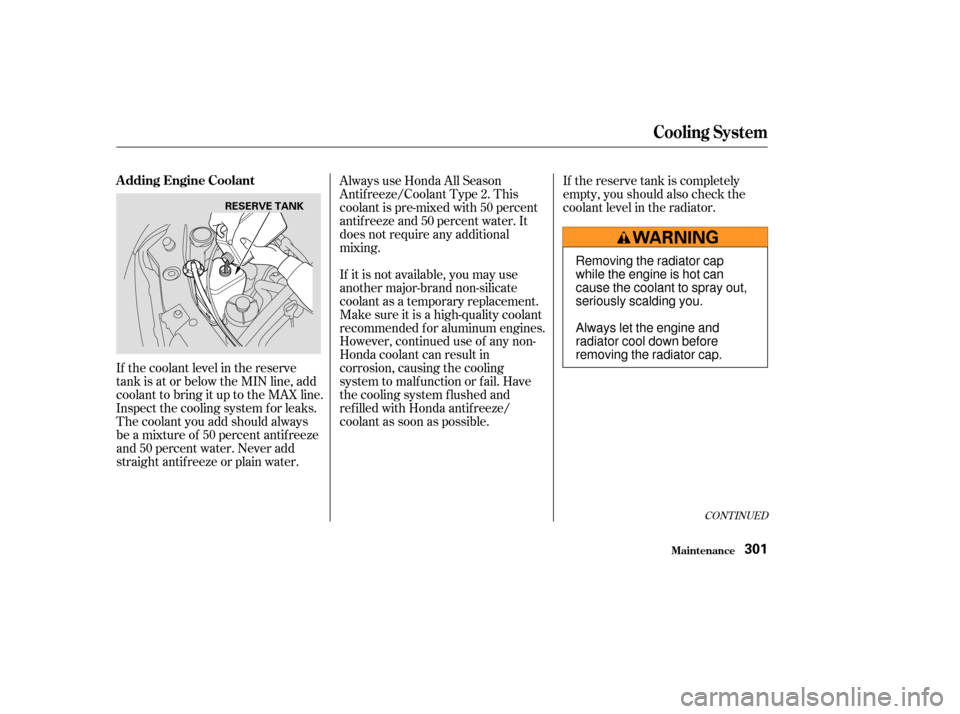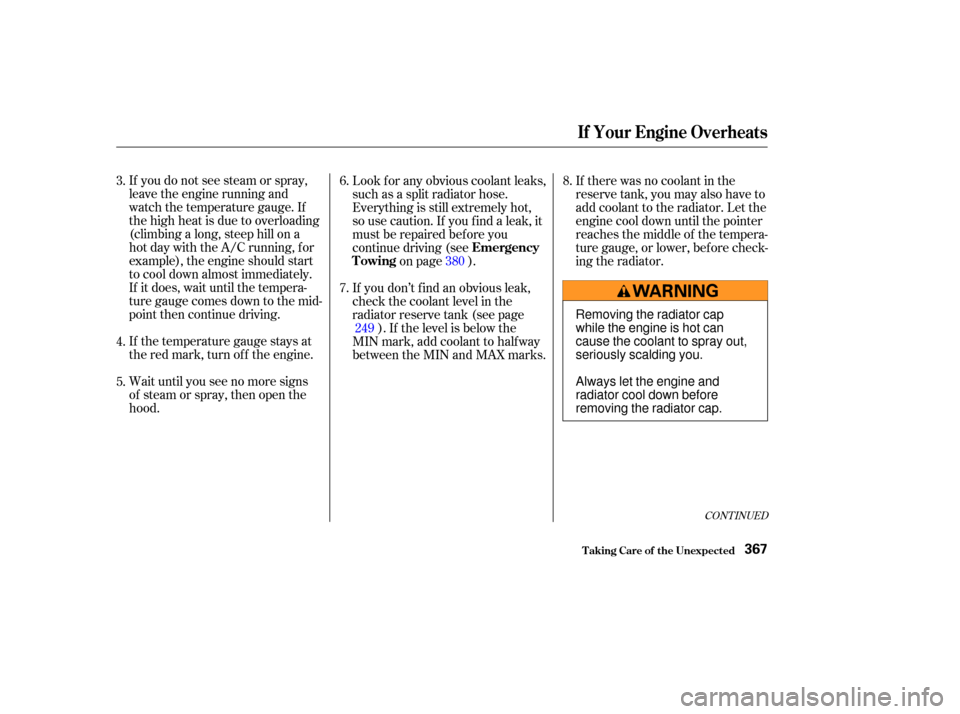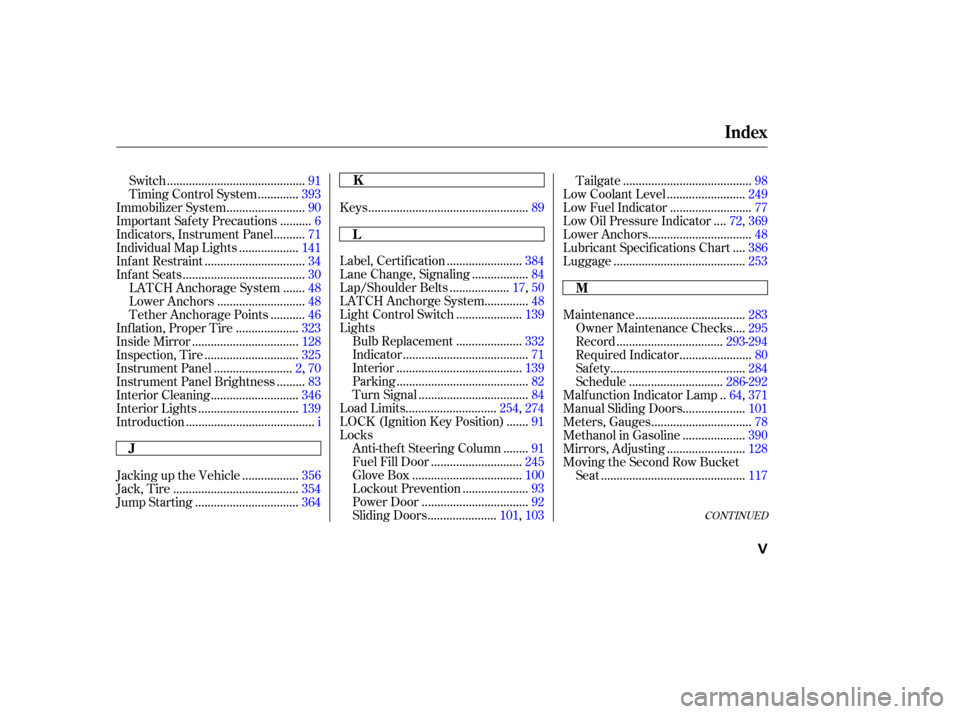Page 304 of 415

If the coolant level in the reserve
tank is at or below the MIN line, add
coolant to bring it up to the MAX line.
Inspect the cooling system f or leaks.
The coolant you add should always
be a mixture of 50 percent antif reeze
and 50 percent water. Never add
straight antif reeze or plain water.If the reserve tank is completely
empty, you should also check the
coolant level in the radiator.
Always use Honda All Season
Antif reeze/Coolant Type 2. This
coolant is pre-mixed with 50 percent
antif reeze and 50 percent water. It
does not require any additional
mixing.
If it is not available, you may use
another major-brand non-silicate
coolant as a temporary replacement.
Make sure it is a high-quality coolant
recommended f or aluminum engines.
However, continued use of any non-
Honda coolant can result in
corrosion, causing the cooling
system to malf unction or f ail. Have
the cooling system f lushed and
ref illed with Honda antif reeze/
coolant as soon as possible.
CONT INUED
A dding Engine Coolant
Cooling Syst em
Maint enance301
RESERVE TANK
Removing the radiator cap
while the engine is hot can
cause the coolant to spray out,
seriously scalding you.
Always let the engine and
radiator cool down before
removing the radiator cap.
Page 305 of 415
Make sure the engine and radiator
are cool.
Turn the radiator cap counter-
clockwise, without pressing down
on it, until it stops. This relieves
any pressure remaining in the
cooling system.
Remove the radiator cap by
pushing down and turning
counterclockwise.The coolant level should be up to
the base of the f iller neck. Add
coolant if it is low.Put the radiator cap back on.
Tighten it f ully.
Pour coolant into the reserve tank.
Fill it to half way between the MAX
and MIN marks. Put the cap back
on the reserve tank.
Do not add any rust inhibitors or
other additives to your vehicle’s
cooling system. They may not be
compatible with the coolant or
engine components.
Pour the coolant slowly and caref ully
so you do not spill. Clean up any
spills immediately. Spilled coolant
could damage components in the
engine compartment.
3. 4.5.
6.
1.
2.
Cooling Syst em
Maint enance302
RADIATOR CAP RESERVE TANK
Page 370 of 415

If you do not see steam or spray,
leave the engine running and
watch the temperature gauge. If
the high heat is due to overloading
(climbing a long, steep hill on a
hot day with the A/C running, f or
example), the engine should start
to cool down almost immediately.
If it does, wait until the tempera-
ture gauge comes down to the mid-
point then continue driving.
If the temperature gauge stays at
the red mark, turn of f the engine.
Wait until you see no more signs
of steam or spray, then open the
hood.Look f or any obvious coolant leaks,
such as a split radiator hose.
Everything is still extremely hot,
so use caution. If you f ind a leak, it
must be repaired bef ore you
continue driving (see
on page ).
If you don’t f ind an obvious leak,
check the coolant level in the
radiator reserve tank (see page ). If the level is below the
MIN mark, add coolant to halfway
between the MIN and MAX marks. If there was no coolant in the
reserve tank, you may also have to
add coolant to the radiator. Let the
engine cool down until the pointer
reaches the middle of the tempera-
ture gauge, or lower, bef ore check-
ing the radiator.
3.
7. 6.
5. 4. 380
249 8.
CONT INUED
Emergency
Towing
If Your Engine Overheats
T aking Care of t he Unexpect ed367
Removing the radiator cap
while the engine is hot can
cause the coolant to spray out,
seriously scalding you.
Always let the engine and
radiator cool down before
removing the radiator cap.
Page 371 of 415

Using gloves or a large heavy
cloth, turn the radiator cap
counterclockwise, without pushing
down, to the f irst stop. This
releases any remaining pressure in
the cooling system. After the
pressure releases, push down on
the cap and turn it until it comes
off.
Start the engine and set the
temperature control dial to
maximum (climate control to
FULL AUTO at 90°F/32°C). Add
coolant to the radiator up to the
base of the f iller neck. If you do
not have the proper coolant
mixture available, you can add
plain water. Remember to have
the cooling system drained and
ref illed with the proper mixture as
soon as you can.Put the radiator cap back on
tightly. Run the engine and watch
the temperature gauge. If it goes
back to the red mark, the engine
needs repair. (See
on page .)
If the temperature stays normal,
check the coolant level in the
radiator reserve tank. If it has
gone down, add coolant to the
MAX mark. Put the cap back on
tightly.
9.
10. 11.
12.
380
If Your Engine Overheats
T aking Care of t he Unexpect ed
Emergency
Towing
368
Page 410 of 415

CONT INUED
.......................
Label, Certif ication .384
.................
Lane Change, Signaling . 84
..................
Lap/Shoulder Belts . 17,50
.............
LATCH Anchorge System . 48
....................
Light Control Switch .139
Lights ....................
Bulb Replacement .332
.......................................
Indicator .71
.......................................
Interior .139
.........................................
Parking .82
..................................
Turn Signal .84
............................
Load Limits .254, 274
......
LOCK (Ignition Key Position) . 91
Locks .......
Anti-thef t Steering Column . 91
............................
Fuel Fill Door .245
..................................
Glove Box .100
....................
Lockout Prevention . 93
.................................
Power Door .92
.....................
Sliding Doors .101, 103 ........................................
Tailgate .98
........................
Low Coolant Level .249
.........................
Low Fuel Indicator .77
...
Low Oil Pressure Indicator . 72,369
................................
Lower Anchors .48
...
Lubricant Specif ications Chart . 386
.........................................
Luggage .253
..................................
Maintenance .283
...
Owner Maintenance Checks . 295
.................................
Record .293-294
......................
Required Indicator .80
..........................................
Saf ety .284
.............................
Schedule .286-292
.
Malf unction Indicator Lamp . 64,371
...................
Manual Sliding Doors . 101
...............................
Meters, Gauges .78
...................
Methanol in Gasoline . 390
........................
Mirrors, Adjusting .128
Moving the Second Row Bucket .............................................
Seat .117
.................
Jacking up the Vehicle . 356
.......................................
Jack, Tire .354
................................
Jump Starting .364 ..................................................
Keys .89
...........................................
Switch .91
............
Timing Control System . 393
........................
Immobilizer System .90
.........
Important Safety Precautions . 6
.........
Indicators, Instrument Panel . 71
..................
Individual Map Lights . 141
...............................
Inf ant Restraint .34
......................................
Inf ant Seats .30
......
LATCH Anchorage System . 48
...........................
Lower Anchors .48
..........
Tether Anchorage Points . 46
...................
Inf lation, Proper Tire . 323
.................................
Inside Mirror .128
.............................
Inspection, Tire .325
........................
Instrument Panel .2 ,70
........
Instrument Panel Brightness . 83
...........................
Interior Cleaning .346
...............................
Interior Lights .139
........................................
Introduction .i
Index
J K
L M
V